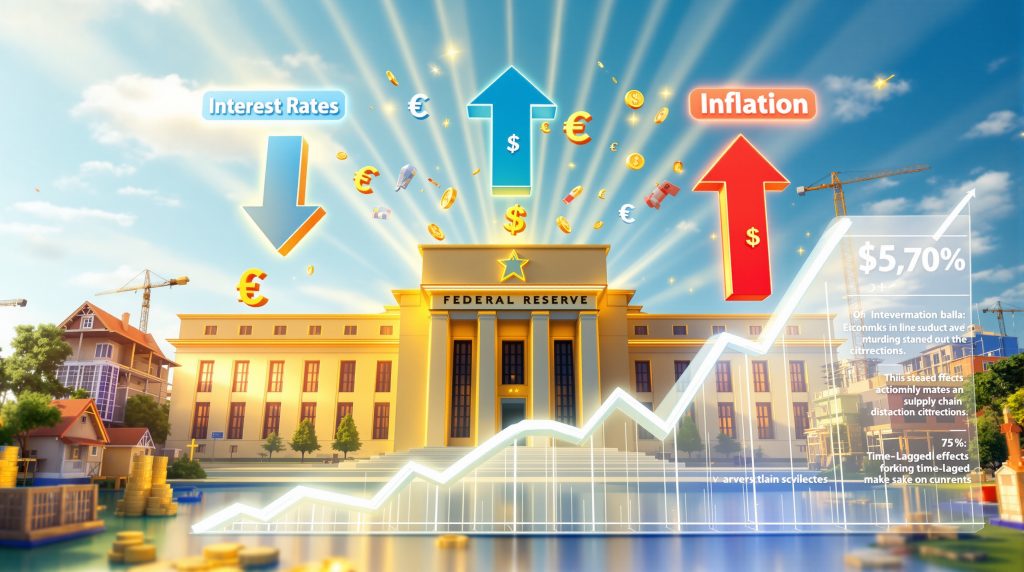The Traditional Relationship Between Interest Rates and Inflation
The conventional economic wisdom suggests that lowering interest rates typically stimulates inflation through several mechanisms. When central banks reduce benchmark rates, borrowing becomes cheaper for both consumers and businesses. This reduced cost of capital encourages spending and investment, which increases aggregate demand throughout the economy.
Consider the housing market as a practical example: When mortgage rates fall from 7% to 3% on a $400,000 home, monthly payments decrease from approximately $2,660 to $1,690. This dramatic improvement in affordability expands the pool of potential homebuyers, driving up housing demand and, consequently, home prices.
Lower interest rates also affect currency values, typically causing depreciation as investors seek higher returns elsewhere. This weakened currency makes imports more expensive, directly contributing to inflation as foreign goods cost more in domestic currency terms.
The Multiple Transmission Channels
The relationship between interest rates and inflation operates through several distinct pathways:
-
Direct interest rate channel: Lower borrowing costs stimulate consumption and investment
-
Exchange rate channel: Currency depreciation makes imports more expensive
-
Asset price channel: Rising asset values create wealth effects that boost spending
-
Credit channel: Expanded lending capacity increases money circulation
-
Expectations channel: Anticipated future inflation influences current pricing decisions
These mechanisms don't operate in isolation but interact in complex ways that can either amplify or moderate the overall inflationary impact of interest rate changes.
Why Lower Rates Don't Always Lead to Higher Inflation
Despite the theoretical relationship, real-world evidence shows that lowering interest rates doesn't always produce the expected inflationary results. Several factors can disrupt this relationship:
The Liquidity Trap Phenomenon
When interest rates approach zero, further reductions may have diminishing returns. In this "liquidity trap" scenario, consumers and businesses may hoard cash rather than spend or invest it, regardless of how low rates go. Japan's experience during its "lost decades" exemplifies this challenge, where despite near-zero rates, inflation remained stubbornly low.
Deleveraging Cycles
Following financial crises, households and businesses often prioritize debt reduction over new spending, regardless of interest rate levels. This deleveraging process can counteract the stimulative effects of lower rates, as occurred following the 2008 global financial crisis when many economies experienced weak inflation despite unprecedented monetary accommodation.
Global Deflationary Forces
Structural factors like aging demographics, technological advancement, and globalization create powerful deflationary pressures that can overwhelm the inflationary impact of lower rates. These forces have contributed to persistently low inflation across developed economies despite extended periods of accommodative monetary policy.
How Central Banks View the Interest Rate-Inflation Relationship
Central banks worldwide operate under frameworks that assume they can influence inflation through interest rate adjustments. The Federal Reserve's dual mandate explicitly targets price stability alongside maximum employment, while other major central banks like the European Central Bank and Bank of England maintain explicit inflation targets, typically around 2%.
The Taylor Rule, developed by economist John Taylor, provides a mathematical framework that many central banks reference when setting rates. This rule suggests appropriate interest rate levels based on inflation gaps (actual versus target inflation) and output gaps (actual versus potential economic output).
However, central bankers increasingly recognize the limitations of interest rate policy alone in achieving inflation targets. Former Fed Chair Janet Yellen acknowledged that "the relationship between unemployment and inflation has become attenuated," highlighting the complexity of modern inflation dynamics.
Recent Global Experiments with Interest Rate Policies
Japan's Negative Interest Rate Experience
Japan's decision to end its negative interest rate policy marked the conclusion of an eight-year experiment with unprecedented monetary accommodation. The Bank of Japan raised short-term rates from -0.1% to a range of 0-0.1%, its first rate increase in 17 years.
This policy shift reflected growing confidence that Japan had finally escaped its decades-long struggle with deflation. However, the global inflation surge from 2021-2023 ultimately proved more effective in helping Japan reach its inflation targets than domestic monetary policy measures alone.
Japan's experience demonstrates how structural factors—rapid population decline, aging demographics, and increased global competition—can create powerful deflationary forces that resist conventional monetary policy tools.
Europe's Negative Rate Experiment
The European Central Bank similarly ended its negative interest rate experiment that began in 2014. Critics argued that policymakers had kept rates too low for too long, creating financial stability risks without achieving desired inflation outcomes.
The ECB's negative rate policy aimed to stimulate economic activity by making savings unattractive and encouraging bank lending. It also contributed to euro depreciation, supporting exports. However, these effects diminished over time as markets adapted to the new interest rate environment.
The Post-Pandemic Inflation Surge
The COVID-19 pandemic created unprecedented economic conditions that challenged conventional understanding of the interest rate-inflation relationship. Despite near-zero rates across major economies, inflation remained subdued during the initial pandemic phase.
However, when economies reopened, inflation surged to multi-decade highs in many countries. This inflation spike occurred despite interest rates remaining at historically low levels, highlighting how supply-side disruptions can drive inflation independently of monetary policy settings.
The Counterintuitive Short-Term Effects
Recent research has identified a counterintuitive relationship between interest rates and inflation in the short term. Some evidence suggests that interest rate increases might initially worsen inflation rather than immediately reducing it—a finding that challenges orthodox monetary theory.
This effect operates through business cost structures and price-setting behavior. When central banks raise rates, companies face higher financing costs for working capital and debt service. If businesses possess sufficient pricing power, they may pass these increased costs to consumers through higher prices, creating a perverse short-term relationship where tighter monetary policy contributes to higher prices.
The resolution of this apparent contradiction lies in understanding different time horizons. While higher rates may create cost-push inflationary pressures in the short term, the traditional demand-reduction effects typically dominate over longer periods as the economy adjusts to tighter financial conditions.
Supply-Side Factors and Their Growing Importance
Traditional monetary policy models focus primarily on demand-side effects, assuming inflation results from excess aggregate demand relative to available supply. However, recent experience has demonstrated that supply-side constraints can create inflation that responds differently to interest rate adjustments.
During 2022, global supply chain disruptions became a dominant driver of core inflation in many economies. The hump-shaped response pattern of inflation to supply chain shocks differs significantly from the more immediate responses typically associated with demand-side monetary policy transmission.
This experience highlights a critical limitation of conventional interest rate policy: central banks cannot directly address production bottlenecks, shipping delays, or commodity price shocks through interest rate adjustments alone.
The Role of Expectations in Monetary Policy Effectiveness
The expectations channel has emerged as increasingly critical in modern monetary policy implementation. This channel operates through the influence of monetary policy on private sector expectations regarding future economic conditions, including inflation.
When central banks credibly commit to maintaining low interest rates for extended periods, these expectations can influence current economic behavior even before policy actions are fully implemented. Conversely, if the public believes inflation will remain high despite policy rate changes, these expectations can become self-fulfilling as businesses set prices accordingly.
Central banks now routinely provide detailed forward guidance about likely future policy paths, attempting to influence long-term interest rates and private sector decision-making through communication as much as through actual policy rate changes.
How Interest Rate Changes Affect Different Economic Sectors
The impact of interest rate changes varies significantly across economic sectors, creating heterogeneous effects throughout the economy:
Housing and Construction
The housing sector typically shows the most immediate and pronounced response to interest rate changes. Lower rates reduce mortgage costs, stimulating demand for housing and construction activity. This sector's sensitivity to interest rates makes it a primary channel through which monetary policy affects the broader economy.
Manufacturing and Capital-Intensive Industries
Industries requiring significant capital investment respond strongly to interest rate changes as their financing costs directly impact profitability. Lower rates can stimulate expansion and modernization projects that might otherwise be unprofitable at higher financing costs.
Consumer Discretionary Spending
Interest-sensitive consumer purchases like automobiles and major appliances typically increase when rates fall, as financing becomes more affordable. However, this relationship depends on consumer confidence and expectations about future economic conditions.
Banking and Financial Services
Financial institutions experience complex effects from interest rate changes. While lower rates reduce net interest margins, they can increase loan volume and asset values. The banking sector's response to rate changes significantly influences how monetary policy transmits to the broader economy.
Time Lags in Monetary Policy Transmission
One of the most challenging aspects of monetary policy implementation is the variable time lag between interest rate changes and their ultimate effects on inflation. These lags create significant complications for policymakers attempting to calibrate appropriate responses to economic conditions.
Research indicates that interest rate changes typically affect:
-
Financial markets almost immediately
-
Real economic activity with lags of 3-6 months
-
Inflation with lags of 12-24 months or longer
These extended and variable lags mean central banks must operate with a forward-looking perspective, adjusting policy based on forecasted economic conditions rather than current data. This forward-looking approach creates inherent uncertainties, as economic forecasts often prove inaccurate, particularly during periods of structural change or crisis.
Global Coordination Challenges
In today's interconnected global economy, the relationship between interest rates and inflation cannot be understood in isolation. Policy decisions in major economies create spillover effects that influence inflation outcomes worldwide.
When the Federal Reserve adjusts interest rates, the effects ripple through global financial markets, affecting currency values, capital flows, and borrowing costs in economies far beyond U.S. borders. These international transmission mechanisms can either amplify or counteract domestic monetary policy effects.
Emerging market economies face particular challenges from these spillovers. When advanced economies reduce interest rates, the resulting capital flows into emerging markets can create asset bubbles and inflationary pressures unrelated to domestic economic conditions. Conversely, when advanced economies raise rates, capital outflows can trigger currency depreciation and imported inflation in emerging markets. The US inflation and tariffs further complicate these global dynamics, creating additional challenges for monetary policy coordination.
Modern Monetary Theory Perspectives
Modern Monetary Theory (MMT) offers an alternative perspective on the interest rate-inflation relationship. MMT proponents argue that government spending, rather than interest rates, represents the primary driver of inflation in economies with sovereign currencies.
According to this view, inflation emerges when government spending pushes aggregate demand beyond the economy's productive capacity. Interest rate adjustments play a secondary role in managing inflation compared to fiscal policy decisions about taxation and spending levels.
While MMT remains controversial among mainstream economists, its emphasis on fiscal-monetary coordination highlights important questions about the limitations of interest rate policy alone in achieving price stability.
What History Tells Us About Interest Rates and Inflation
Historical evidence provides valuable context for understanding the complex relationship between interest rates and inflation:
The Great Inflation and Volcker Shock (1970s-1980s)
The inflation surge of the 1970s culminated in double-digit inflation rates across many advanced economies. Federal Reserve Chairman Paul Volcker responded with dramatic interest rate increases, pushing the federal funds rate above 20% by 1981.
This aggressive tightening successfully broke the inflation cycle but at the cost of a severe recession. The Volcker experience demonstrated that sufficiently determined monetary policy could control inflation, but potentially with significant economic costs.
Japan's Deflationary Experience (1990s-2020s)
Following its asset price bubble collapse in the early 1990s, Japan experienced decades of deflationary pressure despite near-zero interest rates. This experience challenged conventional monetary theory and highlighted how structural factors can overwhelm interest rate effects.
The Bank of Japan pioneered unconventional policies including negative interest rates and massive asset purchases, yet inflation remained stubbornly below target until global inflationary pressures emerged in 2021-2023.
Post-2008 Global Experience
Following the 2008 financial crisis, central banks worldwide implemented unprecedented monetary accommodation, including near-zero interest rates and quantitative easing. Despite these extraordinary measures, inflation remained subdued across most advanced economies for over a decade.
This experience raised fundamental questions about the interest rate-inflation relationship and contributed to the development of new theoretical frameworks emphasizing the role of financial cycles, debt dynamics, and structural factors in inflation determination.
The Future of Monetary Policy and Inflation Management
The evolving understanding of the interest rate-inflation relationship has profound implications for future monetary policy frameworks. Several key developments are likely to shape this evolution:
Integration of Financial Stability Concerns
Central banks increasingly recognize that extended periods of low interest rates can contribute to financial stability risks through asset price bubbles and excessive risk-taking. Future monetary policy frameworks will likely incorporate financial stability considerations more explicitly alongside traditional inflation and employment objectives.
Greater Fiscal-Monetary Coordination
The limitations of interest rate policy alone in addressing certain types of inflation suggest a need for greater coordination between monetary and fiscal authorities. Future frameworks may feature more explicit recognition of how fiscal and monetary policies interact to determine inflation outcomes.
Expanded Toolkit Beyond Interest Rates
Central banks will likely continue developing and refining tools beyond conventional interest rate adjustments. These may include targeted lending programs, macroprudential policies, and more sophisticated forms of forward guidance to address specific economic challenges.
Practical Implications for Investors and Businesses
Understanding the complex relationship between interest rates and inflation has important practical implications:
Investment Strategy Considerations
Investors should recognize that the traditional inverse relationship between interest rates and asset prices may not hold during periods of supply-driven inflation or when central banks face conflicting policy objectives. Diversification across asset classes with different interest rate sensitivities becomes particularly important in such environments. Many investors are turning to inflation hedge insights to protect their portfolios, especially with the gold market surge offering potential stability.
Business Planning and Risk Management
Businesses must consider how interest rate changes might affect their specific industry and competitive position. While lower rates reduce borrowing costs, they may also signal economic weakness or contribute to future inflation that erodes profit margins. The tariffs' impact on investments creates additional complexity for business planning, requiring careful analysis of both monetary policy and trade policy interactions.
Consumer Financial Decisions
Households face complex trade-offs when interest rates change. Lower rates reduce borrowing costs but may also signal economic uncertainty or contribute to asset price inflation that affects housing affordability. Understanding these dynamics can help consumers make more informed decisions about major purchases and financial planning.
FAQ: Common Questions About Interest Rates and Inflation
Do lower interest rates always cause higher inflation?
No, the relationship is not automatic. While lower rates typically stimulate economic activity that can lead to inflation, other factors including consumer confidence, global economic conditions, supply constraints, and structural economic features significantly influence the ultimate inflation outcome.
How quickly do interest rate changes affect inflation?
Interest rate changes typically impact inflation with considerable lags, often 12-24 months or longer. This delayed response creates significant challenges for monetary policy implementation and requires central banks to operate with a forward-looking perspective.
Can central banks control inflation through interest rate policy alone?
Central banks' ability to control inflation through interest rates alone has limitations, particularly when inflation stems from supply-side constraints or global factors beyond domestic monetary policy influence. Effective inflation management often requires coordination with fiscal policy and structural economic reforms.
Why have many economies experienced low inflation despite near-zero interest rates?
Several factors explain this phenomenon, including demographic aging, technological advancement, globalization pressures, deleveraging cycles following financial crises, and declining inflation expectations. These structural forces can create powerful disinflationary pressures that counteract the stimulative effects of low interest rates.
Conclusion: The Evolving Understanding of Monetary Policy
The relationship between interest rates and inflation continues to evolve as economies face new challenges and economists develop more sophisticated understandings of monetary transmission mechanisms. While the traditional view that lower rates stimulate inflation remains valid as a general principle, the real-world relationship proves far more complex and context-dependent.
Central banks now recognize that interest rate policy operates through multiple channels with varying effectiveness depending on economic conditions, financial system structure, and global interconnections. The post-pandemic experience has particularly highlighted how supply-side constraints can drive inflation independently of monetary policy settings.
As economic structures continue evolving and new challenges emerge, monetary policy frameworks will likely incorporate broader toolkits, greater fiscal-monetary coordination, and more nuanced approaches to managing the complex dynamics between interest rates and inflation. With global recession concerns mounting, understanding these relationships becomes even more crucial for effective policy making.
Want to Spot the Next Major ASX Discovery?
Stay ahead of the market with Discovery Alert's proprietary Discovery IQ model, delivering instant notifications of significant ASX mineral discoveries as they happen. Explore why major discoveries lead to substantial returns by visiting our dedicated discoveries page and start your 30-day free trial today.




